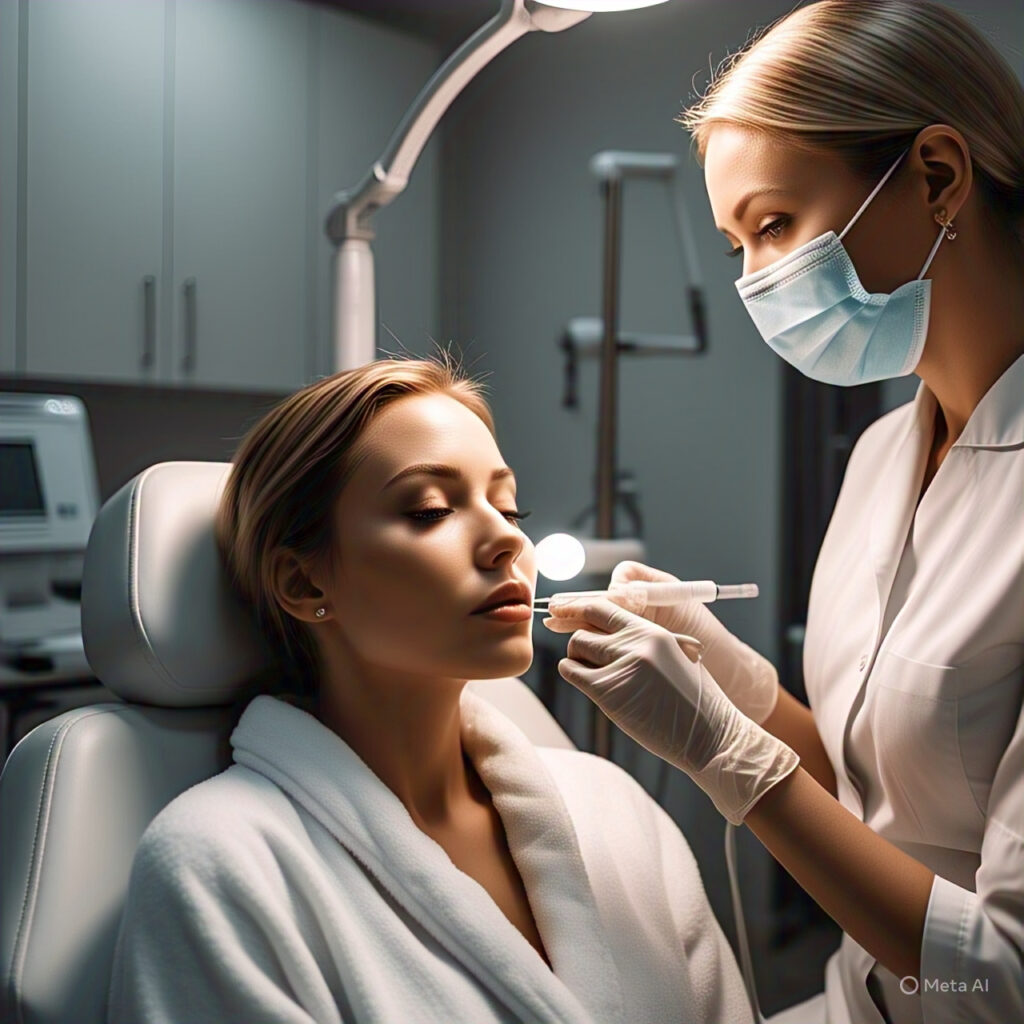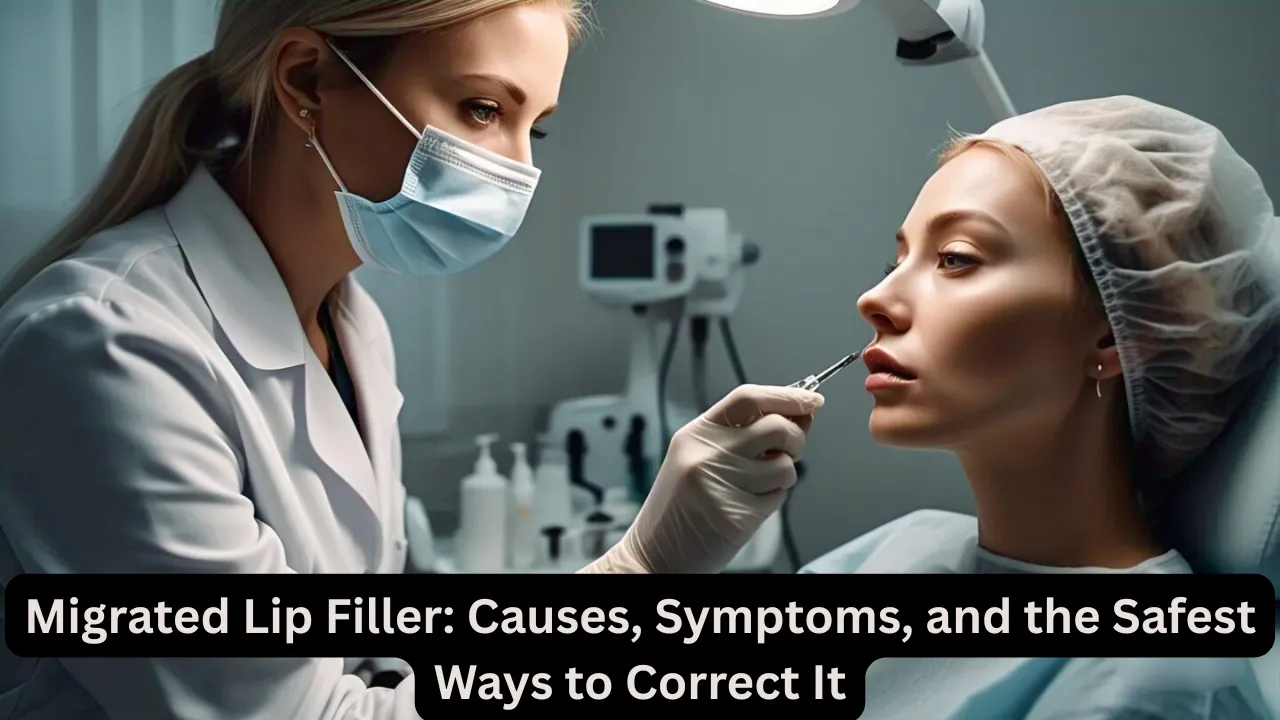Migrated Lip Filler: Causes, Symptoms, and the Safest Ways to Correct It
What Is Migrated Lip Filler and Why Does It Happen?
Migrated lip filler is a cosmetic complication where dermal filler spreads beyond the intended area of the lips, often resulting in a puffy, unnatural appearance above or around the mouth. Unlike typical swelling or bruising that fades after a few days, migrated filler becomes more persistent, sometimes lingering for months if not addressed.
Lip filler migration occurs when the injected product, usually hyaluronic acid-based, moves outside the vermilion border—the natural outline of the lips. This displacement can create a telltale “duck lip” effect, a bulky upper lip, or shadowing that distorts the lips’ contour. Though generally not dangerous, migrated filler is aesthetically undesirable and can indicate improper technique or overfilling.
Common causes of lip filler migration include:
- Overfilling: When too much product is injected in one session or repeatedly without allowing older filler to dissolve.
- Poor technique: Incorrect placement of the filler, especially too high or too superficially, increases the risk of migration.
- Low-quality filler products: Some products have a higher tendency to spread, especially those not designed specifically for the lips.
- Repeated pressure on the lips: Habits like lip biting, sleeping face down, or constant movement in the early healing phase can contribute to migration.
- Anatomy and aging: Everyone’s facial structure and lip elasticity vary. Older individuals with less collagen may experience migration more easily.
Understanding these causes is the first step toward prevention and choosing a qualified injector for lip enhancement procedures.

Symptoms and How to Spot Lip Filler Migration Early
Migrated lip filler doesn’t always present immediately. It can develop subtly over weeks or even months, making it crucial to monitor post-filler changes beyond the initial healing period. Recognizing the symptoms early can help minimize long-term aesthetic concerns and inform treatment decisions.
Key signs of migrated lip filler include:
- Blurring of the lip border: Instead of a well-defined edge, the lips appear smudged or undefined.
- Swelling above the upper lip (mustache area): This often looks like an unnatural shelf or ridge.
- Lumpy or uneven texture: Particularly noticeable when smiling or applying lip products.
- Prolonged swelling: If puffiness doesn’t subside within two weeks, migration may be occurring.
- Discomfort or tightness: Though less common, some people report stiffness or pressure in areas with migrated filler.
It’s important to distinguish these symptoms from normal post-injection effects like temporary swelling, redness, or slight bruising. Typically, early side effects resolve within 7–14 days. Any irregularities persisting beyond this window should be evaluated by a professional.
Dermal fillers are temporary, but left unchecked, migrated filler can harden or distort facial symmetry. An experienced aesthetic practitioner can perform ultrasound diagnostics or manual assessment to confirm whether migration has occurred.

Can Migrated Lip Filler Be Prevented? Best Practices Before and After Your Treatment
The best way to deal with migrated lip filler is to avoid it in the first place. Prevention involves thoughtful planning, realistic goals, and selecting the right injector. Whether you’re getting fillers for the first time or are a seasoned client, the following tips can greatly reduce the chance of migration.
Before your appointment:
- Choose a qualified injector: Look for board-certified dermatologists, plastic surgeons, or nurses with extensive training in facial anatomy and filler application.
- Ask about product selection: Fillers like Juvederm Volbella and Restylane Kysse are designed specifically for the lips and are less likely to migrate.
- Avoid “top-up” culture: Frequent reinjections before the previous filler has fully settled or dissolved increase migration risk.
Aftercare matters too:
- Follow aftercare instructions strictly: Avoid touching, massaging, or applying pressure to the lips for 48 hours post-treatment.
- Minimize strenuous activity: No intense workouts or heat exposure (like saunas or hot showers) for the first two days.
- Sleep on your back: This prevents unintentional pressure that could shift the filler.
- Don’t rush additional treatments: Wait at least 6–9 months before adding more filler unless advised by your injector.
Good communication and regular follow-ups can help catch any signs of migration early. Most experienced injectors now prefer a minimalist, layered approach to achieve natural-looking results while preserving the structural integrity of the lips.

How to Correct Migrated Lip Filler: Dissolving and Refining
If you’re dealing with migrated lip filler, you’re not alone—and the good news is that it can be corrected. The most effective way to reverse migration is through the use of hyaluronidase, an enzyme that dissolves hyaluronic acid fillers safely and quickly.
Here’s how the correction process typically works:
- Consultation and diagnosis: A thorough facial assessment will determine the extent of migration. Your practitioner may suggest a staged approach if multiple correction sessions are needed.
- Hyaluronidase injection: This enzyme breaks down the migrated filler within 24–72 hours. Though safe, it may cause temporary swelling or bruising.
- Healing period: After dissolving, it’s recommended to wait 2–4 weeks before reinjecting any new filler to let tissues normalize.
- Reinjection, if desired: Once the lips return to their baseline, a new plan can be developed for reshaping using better technique and more appropriate volume.
Does dissolving hurt? The injection may sting slightly and local anesthetic is often used to reduce discomfort. Most patients tolerate the procedure well.
Some clients fear losing all volume in the lips after dissolving filler, but the goal is to return to a natural base and rebuild if needed. Working with a skilled injector ensures a more sculpted, refined look moving forward.
Emotional and Psychological Effects of Lip Filler Migration
While migrated lip filler is physically harmless in most cases, it can take a significant toll on confidence and self-image. Cosmetic enhancements are deeply personal, and when results don’t meet expectations, frustration and disappointment can follow.
Many people experience:
- Self-consciousness in social settings or photos
- Regret over having the procedure done
- Anxiety about future cosmetic interventions
- Embarrassment or shame over how the lips appear
Open communication with your provider can help validate these concerns and guide you toward realistic solutions. In some cases, patients benefit from a short break from treatments to reset expectations and rediscover natural beauty standards.
It’s also important to remember that migrated filler is reversible. You don’t have to live with unsatisfactory results, and with the right support, your aesthetic goals can be restored with care and professionalism.
Final Thoughts: Migrated Lip Filler Is Fixable—and Avoidable
Migrated lip filler, while frustrating, is a manageable issue that underscores the importance of proper technique, communication, and aftercare in aesthetic treatments. Whether you’re dealing with migration now or considering fillers for the first time, knowing the risks and solutions puts the power back in your hands.
Choose your injector wisely, never rush touch-ups, and prioritize the health and natural balance of your facial features. In the right hands, lip filler can enhance your beauty—not distort it.
FAQs: Migrated Lip Filler
What is migrated lip filler?
Migrated lip filler occurs when the injectable material used for lip augmentation (usually hyaluronic acid) moves from the area where it was initially injected to other parts of the lips or surrounding areas. This migration can happen due to various factors such as improper injection techniques, excessive movement of the lips, or natural movement of the body’s tissue.
What causes lip filler migration?
Several factors can contribute to migrated lip filler, including:
Incorrect injection technique by the practitioner, leading to uneven distribution.
Excessive massage or manipulation of the lips after the procedure.
Overfilling the lips with filler.
Swelling that causes the filler to shift from its intended location.
Individual tissue response, where the body’s natural movement may cause filler to migrate over time.
How can I prevent lip filler migration?
To avoid migration, it’s crucial to:
Choose a skilled, experienced injector who understands facial anatomy and proper technique.
Follow aftercare instructions, avoiding touching, massaging, or excessive movement of the lips after the procedure.
Can migrated lip filler be fixed?
Yes, migrated lip filler can be corrected. If the filler has shifted or caused an unnatural appearance, an experienced injector can use hyaluronidase (an enzyme that breaks down hyaluronic acid) to dissolve the filler and restore the desired shape. In some cases, re-injecting filler to the correct areas may also be an option.
Will migrated lip filler go away on its own?
In some cases, migrated lip filler may gradually dissipate on its own over time as the body naturally absorbs the hyaluronic acid. However, this can take several months, and it may not resolve the problem completely. If you’re unhappy with the results, it’s best to consult with your injector for corrective measures.
Can migrated lip filler affect the appearance of my lips?
Yes, migrated lip filler can distort the natural shape of the lips, leading to unevenness, lumps, or an unnatural look. This is why seeking a qualified injector and following post-procedure care is essential for achieving the desired outcome.
Conclusion: Understanding and Managing Migrated Lip Filler
Migrated lip filler is a concern for some individuals who seek lip enhancement through injectable fillers. While migration can happen for various reasons, including improper technique, overfilling, or physical manipulation, it is generally a manageable issue. Working with a skilled practitioner who follows proper injection protocols and provides clear aftercare instructions can significantly reduce the risk of filler migration.
If you notice any signs of migrated lip filler, don’t panic. There are effective solutions available, such as hyaluronidase injections, which can help correct the issue. In most cases, migrated filler will not last forever, as the body will gradually absorb it. However, for those seeking immediate solutions or a more natural appearance, consulting with a medical professional is always the best course of action.
Ultimately, when done properly, lip filler can offer beautiful, natural-looking results. By understanding the causes and solutions for migrated lip filler, you can ensure a safe and satisfying experience on your lip enhancement journey.







